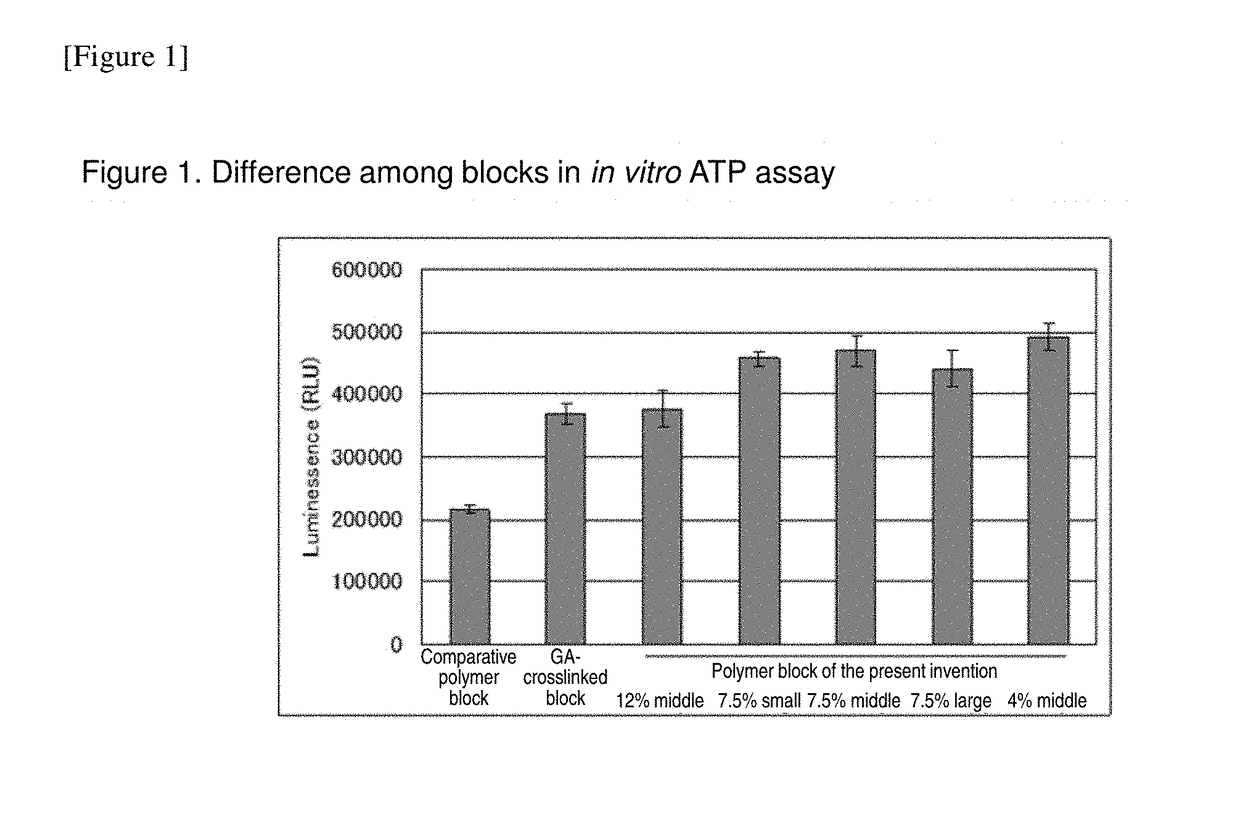Cell construct for cell transplantation, biocompatible polymer block, and method for producing the same
a cell transplantation and polymer block technology, applied in the field of cell transplantation constructs, biocompatible polymer blocks, and methods for producing the same, can solve the problem that cells constructs produced using such glutaraldehyde cannot be used for cell transplantation therapy, and achieve excellent cell survival rate and suppress the necrosis of transplanted cells
- Summary
- Abstract
- Description
- Claims
- Application Information
AI Technical Summary
Benefits of technology
Problems solved by technology
Method used
Image
Examples
example 1
Recombinant Peptide (Recombinant Gelatin)
[0177]CBE described below was prepared as a recombinant peptide (recombinant gelatin) (described in WO 2008-103041).[0178]CBE3[0179]Molecular weight: 51.6 kD[0180]Structure: GAP[(GXY)63]3G (SEQ ID NO:1)[0181]The number of amino acids: 571[0182]The number of RGD sequences: 12[0183]Imino acid content: 33%[0184]Substantially 100% of amino acids are derived from the GXY repeat structures. The amino acid sequence of CBE3 does not contain serine, threonine, asparagine, tyrosine, and cysteine. CBE3 has an ERGD sequence (SEQ ID NO:10).[0185]Isoelectric point: 9.34, GRAVY value: −0.682, 1 / IOB value: 0.323
Amino acid sequence (SEQ ID NO: 1 in the sequencelisting) (same as SEQ ID NO: 3 in WO 2008 / 103041except that X at the end was modified to ″P″)GAP(GAPGLQGAPGLQGMPGERGAAGLPGPKGERGDAGPKGADGAPGAPGLQGMPGERGAAGLPGPKGERGDAGPKGADGAPGKDGVRGLAGPIGPPGERGAAGLPGPKGERGDAGPKGADGAPGKDGVRGLAGPIGPPGPAGAPGAPGLQGMPGERGAAGLPGPKGERGDAGPKGADGAPGKDGVRGLAGPP)3G
example 2
Production of Recombinant Peptide Porous Body (Polymer Porous Body)
[0186]A cylindrical cup-shaped vessel made of aluminum, having a thickness of 1 mm and a diameter of 47 mm, was prepared. When the curved surface of the cylindrical cup is defined as a side surface, the side surface is closed with 1-mm aluminum, and the bottom surface thereof (planar circular shape) was also closed with 1-mm aluminum. On the other hand, the upper surface thereof was opened. In addition, only the inside of the side surface was uniformly lined with Teflon (registered trademark) having a thickness of 1 mm, and consequently, the inner diameter of the cylindrical cup was found to be 45 mm. Hereinafter this vessel is referred to as a “cylindrical vessel.”
[0187]A CBE3 aqueous solution was prepared, and the prepared CBE3 aqueous solution was then poured into the cylindrical vessel. Using a cooling shelf board, the CBE3 aqueous solution was cooled from the bottom surface in a freezer. For the cooling operatio...
example 3
Evaluation of Pore Size and Space Occupation Percentage of Recombinant Peptide Porous Body
[0193]With regard to the CBE3 porous body obtained in Example 2 and the simply frozen porous body obtained in Comparative Example 1, the pore size and space occupation percentage of each porous body were evaluated. The obtained porous bodies were each subjected to thermal crosslinking at 160° C. for 20 hours, so as to insolubilize them. Thereafter, the porous bodies were swollen with a normal saline for a sufficient period of time. Thereafter, a frozen tissue section was prepared using a microtome, and then, a HE (hematoxylin-eosin)-stained specimen was produced. From the specimen, a section image with a real scale of 1.5 mm was prepared, and the area of each pore was measured. Then, the diameter of a circle, which was obtained when the measured area was calculated relative to a circle, was calculated, and the obtained circle diameter was defined as a pore size. A mean value of 20 or more pores...
PUM
| Property | Measurement | Unit |
|---|---|---|
| melting point | aaaaa | aaaaa |
| size | aaaaa | aaaaa |
| size | aaaaa | aaaaa |
Abstract
Description
Claims
Application Information
 Login to View More
Login to View More - R&D
- Intellectual Property
- Life Sciences
- Materials
- Tech Scout
- Unparalleled Data Quality
- Higher Quality Content
- 60% Fewer Hallucinations
Browse by: Latest US Patents, China's latest patents, Technical Efficacy Thesaurus, Application Domain, Technology Topic, Popular Technical Reports.
© 2025 PatSnap. All rights reserved.Legal|Privacy policy|Modern Slavery Act Transparency Statement|Sitemap|About US| Contact US: help@patsnap.com



